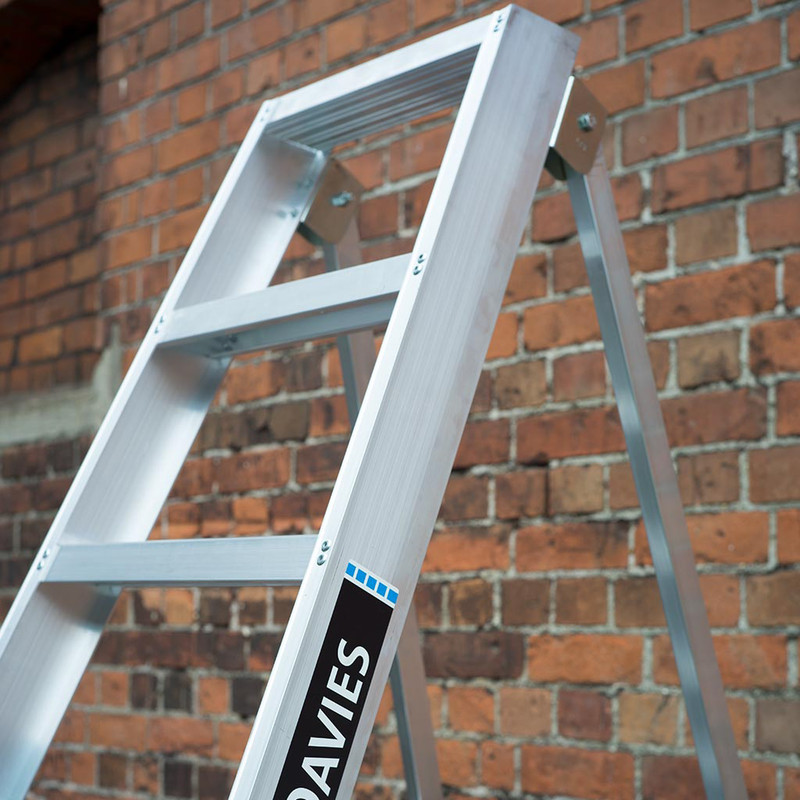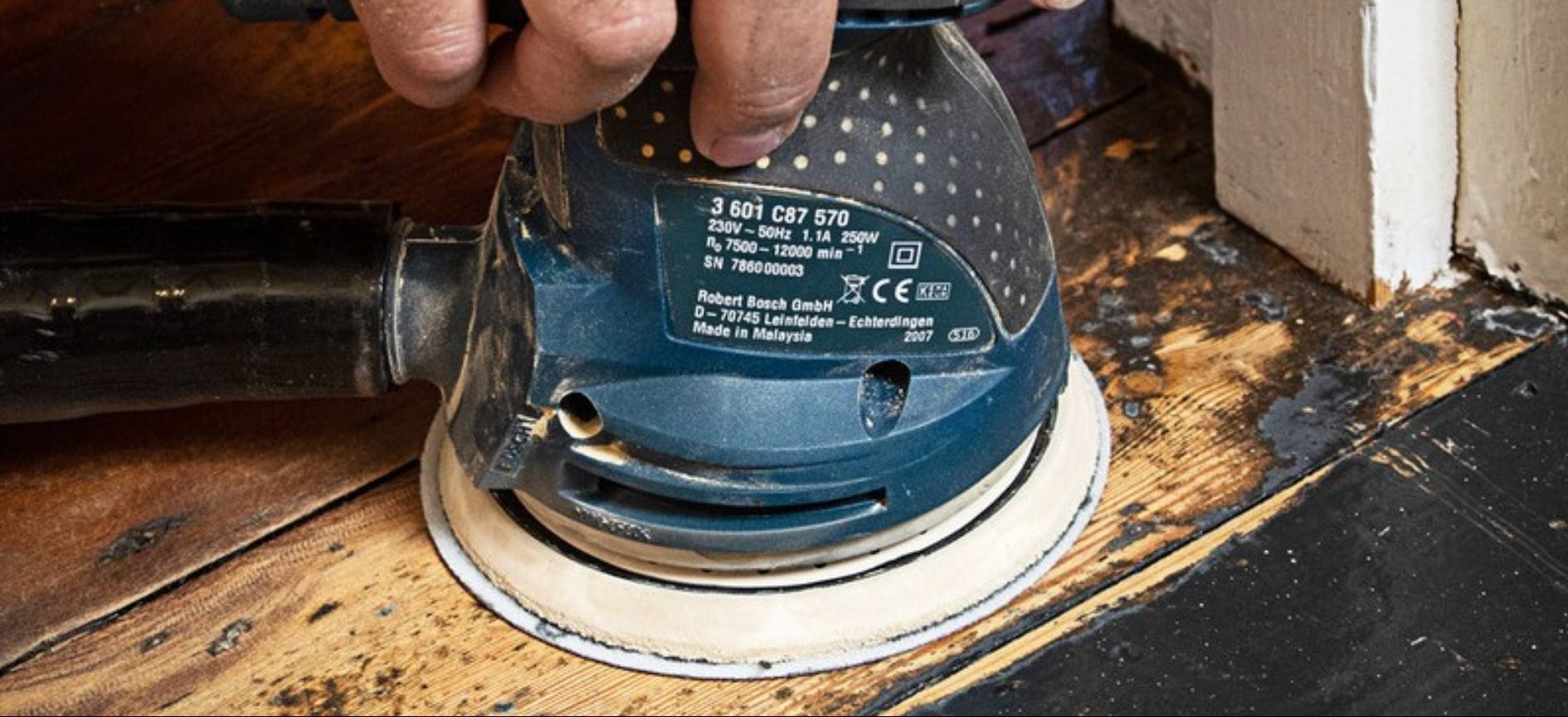From reaching the top shelf in a kitchen cupboard to cleaning gutters and fixing roofs, they make our lives easier and are a great addition to trade and DIY toolkits alike. But with so many types of ladder to choose from, picking the right one can be hard.
Whether you’re a DIY enthusiast or a professional tradesperson, you’ll want to consider more than just the ladder’s height. Think about storage space, weight, and what you need it for. Do you need a platform to store tools while you work? Or are you after a space-saving telescopic ladder? There’s a ladder for every situation and purpose.
You’ll also find loft ladders, which can make it easy and efficient to access the attic space in your property. If you have a wide range of projects to tackle, a combination ladder can be used in a number of ways for more flexibility.
Types of Ladders

Extension Ladders
Extension ladders are made of two or more sections that slide and lock into place – so they can be used at. different heights, usually between 2.2m - 5.5m. They’re often used for cleaning gutters, painting, and accessing tall shelves. Extension ladders have a stabilising base to stop them falling and are usually leant against a wall.
They’re taller than other ladder types, so they're perfect for high jobs. Extension ladders are most commonly made of aluminium, making them lightweight and easy to move around.
Extension ladders can be bulky and difficult to store – especially if you choose a longer ladder. They can also come with a higher price tag than other ladder types, but there aren’t many alternatives if you need to work up high. Due to their height, extra care needs to be taken when in use.
Advantages
-
Can be adjusted to various heights
-
Lightweight
-
Stabilising base for safety
Things to Consider
-
Can be bulky and difficult to store
-
Higher price tag than shorter ladders
-
Greater height means extra care needed

Combination Ladders
Combination ladders have lots of sections so they can be assembled into different positions. An A-frame position looks like a triangle and is perfect for lower height jobs. The extension position is for getting up high using the full length of the ladder. The scaffold position is lower with a platform on the top for storing tools and materials while working.
Combination ladders are perfect for DIY jobs around the home and garden, such as painting walls or trimming trees. Made of aluminium or fibreglass, they are lightweight and easy to move around. They fold up to save space, and are very stable due to their wide legs.
Combination ladders have a limited weight capacity, often lower than extension ladders. They're also shorter when fully extended, usually around 3m. Combination ladders can be more complex to set up than others – which can be dangerous if they’re not secured properly.
Advantages
-
Versatile
-
Extra stability
-
Lightweight and fairly compact
Things to Consider
-
Weight and reach limits
-
Complex set up
-
Greater care needed for stability
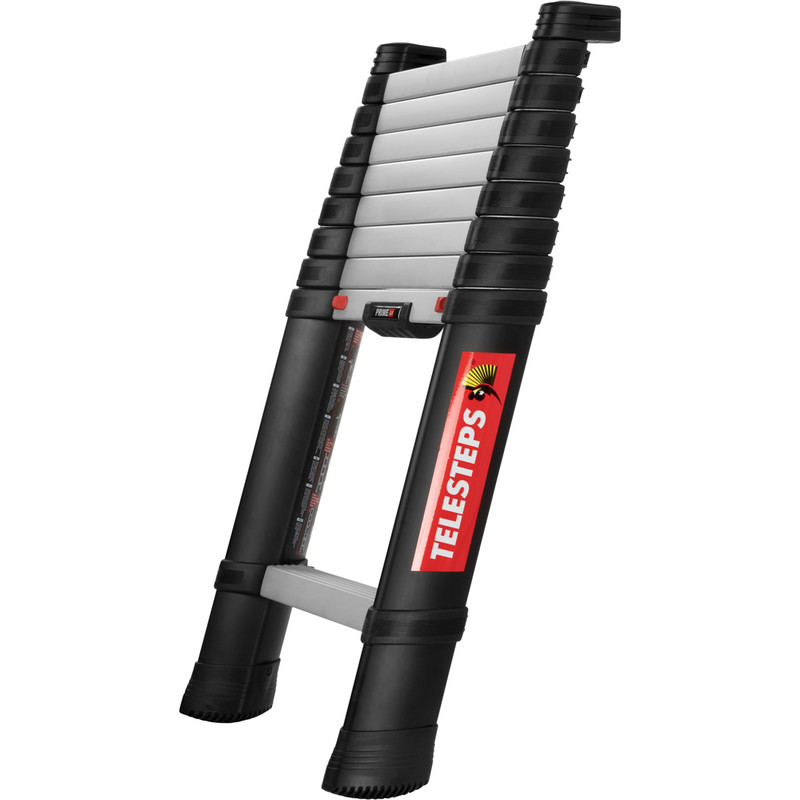
Telescopic Ladders
Telescopic ladders are collapsible, with the ladder fully slotting inside itself when not extended. They have a range of heights, more than 4 metres for some models, and are ideal for decorating, and both indoor and outdoor maintenance.
These ladders are versatile, as they can be extended to different heights for different jobs. Telescopic ladders are also easy to set up and collapse. They’re made of aluminium which makes it easy to move around from job to job, especially when fully collapsed.
Telescopic ladders have a limited height and weight they can stand, often lower than extension ladders. They can also come at a higher price tag than other ladders. Telescopic ladders must be set up correctly or the ladder could retract – although telescopic ladders from Toolstation have safety features to prevent this.
Advantages
-
Compact and light
-
Can be extended to various heights
-
Easy to set up
Things to Consider
-
Low height and weight limits
-
Higher price tag
-
Risk of the ladder retracting if not set up correctly
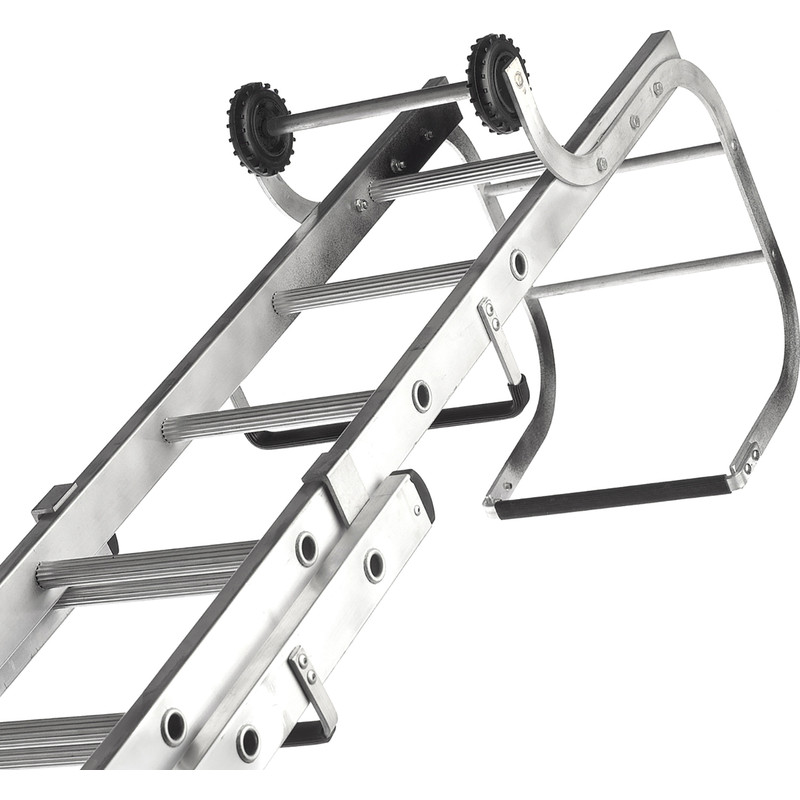
Roof Ladders
Roof ladders extend very high, sometimes more than 7m, and have a curved top to hook on the edge of a roof. They’re most commonly used by tradespeople whio need access to a roof, such as for installing solar panels or carrying out repairs. Roof ladders are made of aluminium so they're relatively lightweight.
These ladders are the only type that are safe enough to be used when working on roofs, so are an essential for a number of projects. Roof ladders can be used for simple roof and gutter repairs to solar panel installation, making them fairly versatile.
Roof ladders often come at a higher price tag than other types and as they’re only used for roofs, you may not use it enough to justify the higher cost. Although roof ladders are the safest option compared to other ladders for working up high, they can still come with more risk than alternatives like scaffolding.
Advantages
-
Lightweight
-
Only type safe for roofs
-
Used for small and large jobs
Things to Consider
-
Higher price tag than other types
-
Limited uses
-
More risk than scaffolding
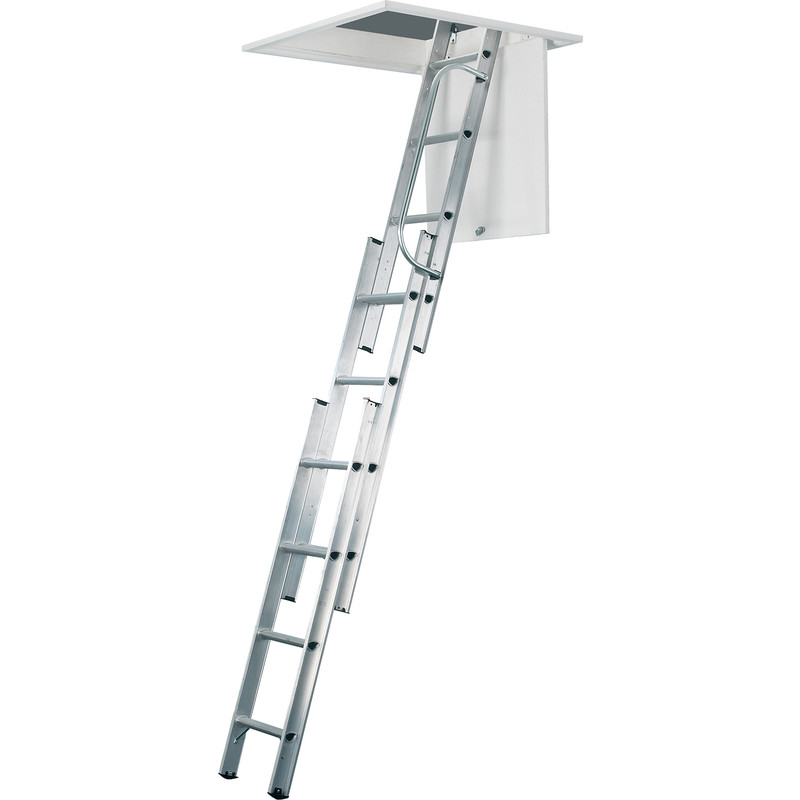
Loft Ladders
Loft ladders are installed on a trapdoor or hatch leading up to the attic, allowing safe and easy access. They’re mainly used by DIYers at home, but also have their place in some offices that have a loft space. Aluminium loft ladders work like extension or telescopic ladders, while timber loft ladders usually fold down from the hatch.
A loft ladder is perfect for saving space – it’s simply stored up in the attic until you need it. They’re also easy to install for confident DIYers which is great if you want to save a bit of money on labour. Loft ladders are the safest and most convenient way to access the attic.
Like all types of ladder, there are weight limits – consider what you’re carrying up and down to make sure the loft ladder is safe and secure. Also, the size and shape of the loft can affect which type of loft ladder can fit, which can limit your options.
Advantages
-
Safe and convenient loft access
-
Space saving
-
Easily installed by confident DIYers
Things to Consider
-
Weight limits
-
Loft size and shape can limit options
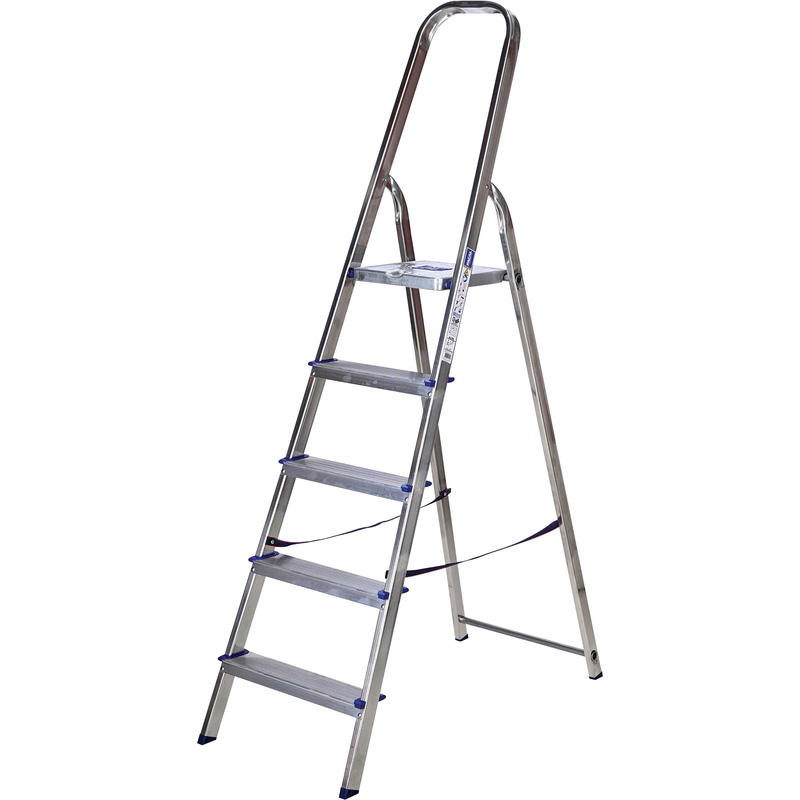
Platform Step Ladders
Platform step ladders are a smaller ladder type with a platform at the top for storing tools and materials, as well as a stable step. They’re often made of fibreglass, aluminium or steel, and range between 2m and 4m tall. Platform step ladders are used by tradespeople and DIYers for indoor and outdoor painting and maintenance .
The platform and A-frame structure of platform step ladders makes them relatively stable. They also provide a comfortable standing area for long projects, and allow you to store things instead of holding them while you work. Platform step ladders are versatile, perfect for everything from basic household tasks to large-scale trade projects.
Platform step ladders can be bulky and harder to store as they don’t collapse as much as some other ladders. They also have a limited reach compared to extension ladders. Because these ladders have four legs, they’re also not suited to uneven surfaces as they’re likely to wobble.
Advantages
-
Stable
-
Handy platform
-
Versatile uses
Things to Consider
-
Bulky
-
Limited reach
-
Not suited to uneven surfaces

Swingback Step Ladders
Swingback step ladders have steps on one side and make an A-frame shape when in use. They have a hinge which can be used to fold the ladder in half for storage. Swingback step ladders come in a range of heights, from just over 1m, to almost 4m tall. They’re used by tradies and DIYers indoors or outdoors for projects such as painting or small home improvements.
This type of ladder is typically lightweight and easy to move around – especially the smaller models. They have multiple applications, are simple to use, and easily secured. Swingback step ladders are also relatively affordable depending on the size.
Swingback step ladders have a limited height, and are generally the smallest type of ladder. They’re also less stable than other types of ladders as they have four legs which make them unsuitable for uneven ground – especially for taller ladders or when you’re standing on the top step.
Advantages
-
Lightweight
-
Versatile
-
Relatively affordable
Things to Consider
-
Limited height
-
Less stable than other ladder types
Key Ladder Features
Height
The taller the ladder, the higher you’ll be able to reach. You’ll find taller ladders come with more risk and are likely to be less stable, while shorter ladders offer better balance. However, some jobs such as roof repairs will need extra-tall ladders – these will often have extra safety features such as a curved top which hooks on the roof.
Material
Most ladders are made of aluminium. This is a lightweight material which makes it easier to move around from job to job and around the home. Fibreglass ladders are similarly lightweight but have the added benefit of being resistant to electricity – which is important if you’re likely to be working with or closeby to an electrical supply. You’ll find some loft ladders are made of timber, which are an attractive alternative to aluminium.
Treads
Ladder treads are the number of individual steps a ladder has – taller ladders have more treads, and shorter ladders have less. Treads are strong enough to take a lot of weight without bending or snapping and they’re also slip resistant, so they may have rubber tops or grooves. Trade-grade ladders may have wider treads with more space between making them better suited to work boots.

